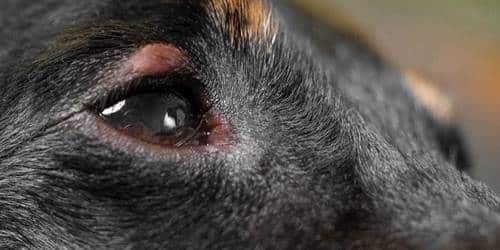So you’re proud to be a dog owner, and not so long after getting your pet, you start noticing some redness in your dog’s eyes. Now, you’re torn between calling a vet or just dismissing it as just a normal reaction that’ll soon fade away. Before you do anything further, you should know that dogs suffer from allergies just like humans, and the earlier you understand the causes and symptoms of these allergies and how to treat them, the easier your pet-keeping journey will be. That said, here’s all you need to know about allergies in dog eyes.
What Are Dog Eyes Allergies?
Allergies in dogs’ eyes are also called allergic conjunctivitis. The term describes inflammation of the eye that results from environmental allergens like pollen and mold. Your dog is more likely to experience this allergy if it has other skin-based allergy symptoms.
Types Of Dog Eyes Allergies
There are two major types of allergies in dog eyes: Follicular conjunctivitis in puppies and allergic conjunctivitis in adults.
Follicular Conjunctivitis in Puppies
Follicular conjunctivitis is common in a young, healthy dog with red, goopy eyes. Short courses of medication are usually effective, but the problem will reoccur until the pet is taken for evaluation. The conjunctiva contains immune cells (lymphoid follicles) that are normally invisible, but in a pet with follicular conjunctivitis, the body overreacts to allergens such as pollen, dust, or grass, and the follicles swell.
The reaction is allergic in nature, but it is caused by an immune system defect rather than a true allergy. Because their immune systems have not yet matured, young dogs are affected, but they usually outgrow the condition by the age of two. Red eyes, watery or mucoid discharge, rubbing at the eyes, and visible follicles on the third eyelid conjunctiva are all symptoms of follicular conjunctivitis.
Allergic Conjunctivitis In Adult Dogs
Adult dogs with recurrent or persistent conjunctivitis that is not caused by another eye disease may have allergic conjunctivitis. These dogs are typically diagnosed with systemic allergies (i.e., atopy) and exhibit other symptoms such as itching, skin and ear infections, and hair loss that coincide with conjunctivitis flare-ups. Only the eyes are sometimes affected, and flare-ups may be seasonal depending on the offending allergen. This allergy, like follicular conjunctivitis, causes redness, discharge, and eye rubbing, but lymphoid follicle enlargement is rarely seen.
What Causes Dog Eye Allergies?
About anything can cause eye allergies in dogs, but the most frequent causes of these allergies are:
- Mold
- Tree and grass pollen
- Household cleaning agents
- Smoke
- Perfumes
- Medications
- Certain ingredients used in dog food
- Fabrics
While these are some of the frequent causes of eye allergies in dogs, you should conduct a proper test on your dog to determine the underlying cause of the allergy. You can either run a do a series of checks on your dog to determine whether the causes are outdoors or indoors, or you can take your dog to a vet for allergy screening.
What Are The Symptoms of Eye Allergies In Dogs?
The most common symptom is redness of the eyes, after which you may notice some other symptoms like squinting of the eyes, pawing at the face, and discharge coming from the eyes.
Itchy Skin And Dog Eye Allergy: What Is The Connection?
Like we mentioned earlier, dogs with skin allergies are more likely to suffer from eye allergies. So, make sure to mention it to the vet if your dog has had allergy-based skin reactions.
Affected dogs are typically under 3 years old when they first exhibit symptoms. Although all dog breeds are susceptible to allergic conjuctivitis, common breeds with a proclivity for this condition include:
- Boxer
- Cocker Spaniel
- French Bulldog
- German Shepherd
- The Golden Retriever
- Labrador Retriever
- Poodle
- West Highland White Terrier
Read Also: Signs a Dog Eye Ulcer Is Healing: Recognizing Positive Progress
Diagnosing Dog Eyes Allergies
Although a test known as “conjunctival cytology” can reveal inflammatory cells that confirm an allergic conjunctivitis diagnosis, the cells are not always present. As a result, many veterinarians will use the elimination method to diagnose eye allergies.
Several brief tests may be performed by your veterinarian to rule out diseases with similar symptoms, such as eye infections, dry eye, or corneal ulcers. Other details, such as your dog’s age, breed, and history of itchy skin, can also point your veterinarian in the right direction.
A biopsy of the conjunctival tissue around the eyes, performed while your dog is under general anesthesia, may be required in rare cases to obtain a definitive diagnosis or to rule out other, more serious causes of red eyes.
A new test known as the conjunctival provocation test has shown promise as a quick and easy way to diagnose allergic conjunctivitis. However, it is not currently widely available and would almost certainly be performed by veterinary dermatologists rather than your general practice veterinarian.
How To Treat Dog Eye Allergies?
Follicular conjunctivitis is self-limiting, which means it will go away on its own. Pets with copious discharge, self-trauma from itching, or who appear uncomfortable may be treated to alleviate symptoms while their immune system matures and adjusts to tamp down the overactive immune response. Treatment typically lasts several months before tapering or ceasing, and may include:
Sterile eye wash can rinse away debris, allergens, and discharge, reducing the immune response and improving comfort.
Steroid eye drops — Steroid eye drops can help reduce conjunctival inflammation.
Topical immunomodulators, such as tacrolimus and cyclosporine, can help regulate the local immune system of the eye and reduce the overactive immune response.
Consultation with a dermatologist — To desensitize dogs with severe allergies and conjunctivitis, they may require oral steroids, immunosuppressants, or immunotherapy.
Although antihistamines can help people with eye allergies, they have a variable effect on dogs with this condition. As a result, eyedrops containing steroids are frequently used to treat dogs with allergic conjunctivitis.
It’s important to note that steroid-based eye drops can be extremely harmful to dogs suffering from other, similar eye diseases, so never begin treatment without first consulting your veterinarian.
In severe cases, oral medications may be required in addition to eye drops.
After Treatment?
A recheck is usually recommended after one to two weeks of treatment so that your veterinarian can evaluate how well the medications worked.
If there is only minor improvement, your dog can be seen by a veterinary dermatologist, who can perform allergy testing and other diagnostics to determine which allergens are causing your dog’s allergic conjunctivitis.
Allergens are removed whenever possible, often by changing the diet. If eliminating allergens is not possible, your dog’s dermatologist may recommend immunotherapy as a long-term treatment option.
If the allergen cannot be removed or treated with immunotherapy, a dog with allergic conjunctivitis will most likely have flare-ups throughout her life. Fortunately, the symptoms of allergic conjunctivitis are relatively mild, and affected dogs generally live long and happy lives with proper treatment and management.
How To Prevent Dog Eye Allergies
If your pet is prone to eye allergies, you can take steps to limit his or her exposure to airborne allergens and thus lessen the severity of flare-ups. Always adhere to your veterinarian’s treatment plan and administer medications as directed. Furthermore, your pet may benefit from:
- Applying a lubricant gel or ointment to the eye before going for a walk or being exposed to the elements.
- Eyewash — As needed, use eye wash to rinse debris from the eyes prior to applying topical medication, but never immediately afterward.
Read Also: HOW TO GET DOG PEE SMELL OUT OF COUCH
Can I Give My Dog Human Eye Drop For Allergies?
Human medication, including eye drops, is not always the same for dogs. Never treat your dog with human medication without first consulting a pet care specialist. Using the incorrect eye drops can result in significant pain, damage, and blindness.
How Can I Treat My Dog’s Eye Infection Without Going To The Vet?
You can flush out any irritants in your dog’s eye with saline eye drops. These drops will not hurt your dog and may provide some temporary relief to his inflamed eye. Saline eye drops can be purchased at a pharmacy, online, or at a pet store and squirted gently into your dog’s eye.
In Conclusion,
Eye allergies in dogs are fairly common. Allergic conjunctivitis is painful and itchy, similar to hay fever. Not to mention that if left untreated, it can lead to secondary infections. Other symptoms of allergies, such as skin problems or digestive issues, may accompany signs of dog eye allergies. If you suspect your dog has dog eye allergies, make an appointment with your veterinarian as soon as possible.
Related Articles
- WHAT YOU SHOULD KNOW ABOUT FLEA DIPS FOR DOGS
- How To Keep Flies Off Dogs| Home Remedies
- BREWER’S YEAST FOR DOGS: What Are The Benefits?
- Best OTC and Natural Appetite Stimulant For Dogs
- HOW LONG DO COCKATOOS LIVE?






